A relationship between an agent and a client is about communicating, meeting expectations, and adapting to changing circumstances.
Like any relationship, that between a customer and a service provider is a give and take. The tricky part is knowing how much to give and how much to take, and when, and in what contexts. There are certain expectations that clients have of professionals, and that human beings in general have of each other.
Different perspectives
It may be tempting to argue that the stakes are higher for you than for your potential clients. After all, if you fail to meet their expectations, you may lose their business. On the other hand, if they don’t meet whatever expectations you have, you will likely still work with them.
But it is important to see things from the client’s perspective. They don’t just want advice or problem-solving; they want a reliable professional and, at some level, personal relationship. They want to be able to trust you, and for you to be level with them.
This means that clients can put a lot of pressure on themselves, even when it is unnecessary. In addition to having expectations for you, they have expectations of themselves.
Some clients may conceive of themselves as well-read, as expert negotiators, as visionaries, or as idealists. They bring their own histories and preconceptions, dreams and biases, to each interaction. They have goals to accomplish and criteria to meet.
Meeting people, meeting challenges
Coming into such interactions can be daunting for agents and clients alike. Even though each person arrives with expectations, on some level, neither know what to expect. But this truth is exactly what allows you to build a strong client relationship.
You need to meet each client in their individual situation. You have a wealth of expertise and insight, but not all you have to offer will be useful to a particular client. Even beyond your education and experience in the real estate world, you come to the table with a completely unique background and life history, as will each of your clients.
It is important to acknowledge where your own biases lie, and to be aware of areas of which you have only a provisional understanding. Do your best to educate yourself on your blind spots, and realize that you can learn as much from your clients as they can learn from you.
The hallmark of a successful relationship is that you can learn from each other. You both have something to offer. Admittedly, it is you who are actually providing a paid service, but each client you serve will enrich your ability to serve both current and future clients.
Growth mindset
There are two basic mindsets in learning: a growth and a fixed mindset. A fixed mindset touts inborn abilities and traits, immutable characteristics. Under this mindset, what you have to offer is cut and dry.
In terms of a growth mindset, however, the situation changes. Relationships are not static. They are objects to be developed for mutual benefit. Each day you spend with a client can be a positive product of the day before.
With this attitude, you will encourage both yourself and your client to keep working with each other. Instead of simply working toward an end goal, work on personal development along the way. This means developing your client relationship so that current clients become recurring clients and you and your client base each continue to grow.




 Where do we send your free Great Agent demo?
Where do we send your free Great Agent demo?





 We just need some facts about your organization:
We just need some facts about your organization:
COMMENTS